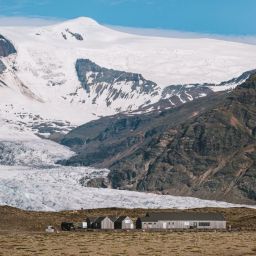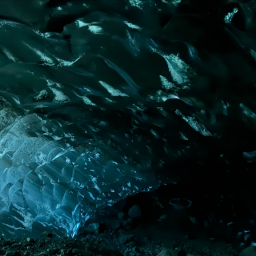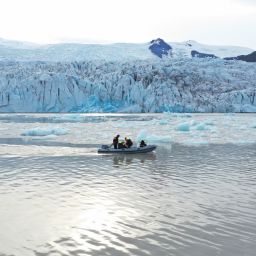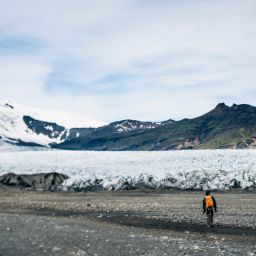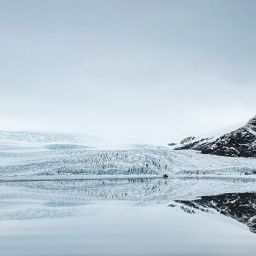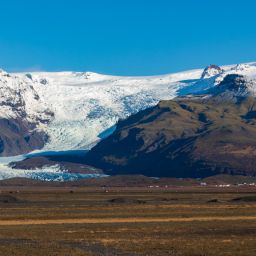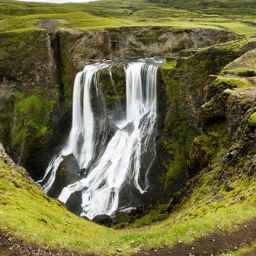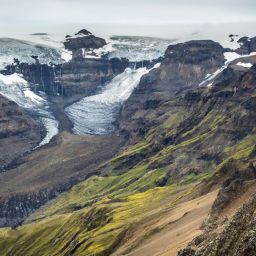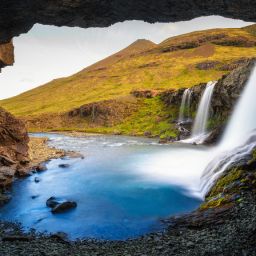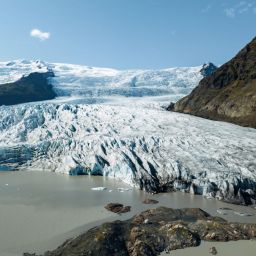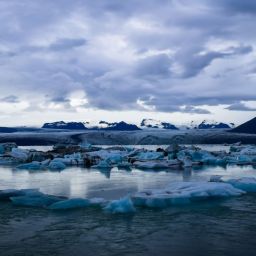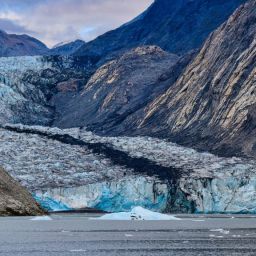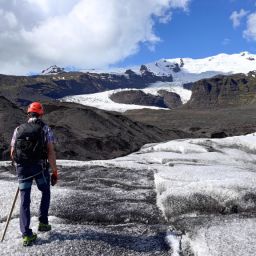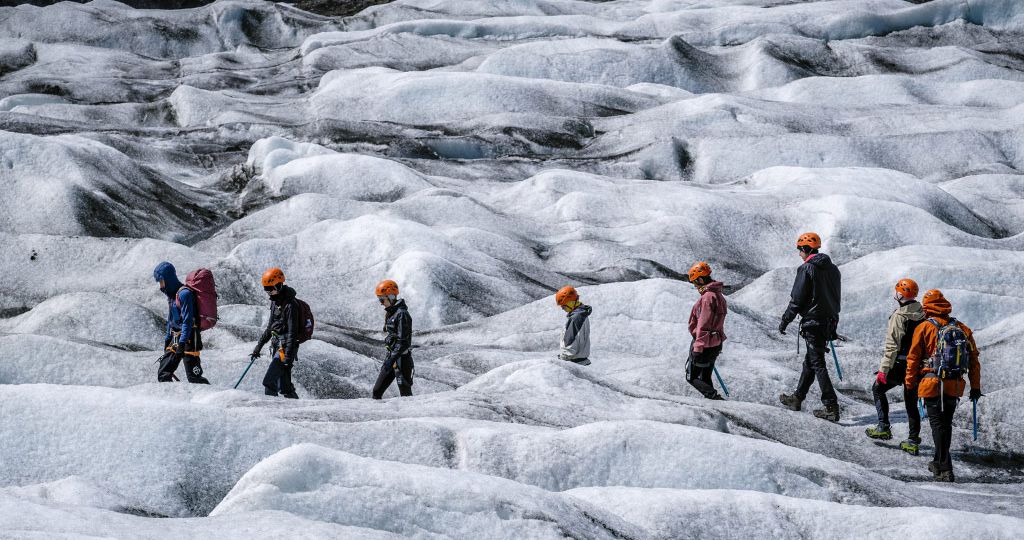
On a fine day, there’s surely nothing better than the view from atop one of Iceland’s glaciers. Blessed with clear visibility and blue skies, you can see for miles and drink in the country’s incredible landscapes. But in Iceland, weather conditions can change rapidly. This unpredictability is what makes it so special when the clouds lift or the rain eases. Yet it also has implications for anyone who plans to hike here, even in summer. In this piece, we’ll take a look at what you need to know to make sure you stay safe if you’re hiking around glaciers in Iceland.

The glacial landscape is full of extremes like deep crevasses and melting ice water.
What does hiking in and around a glacier look like in reality?
Hiking on a glacier is something you should only contemplate if you’re accompanied by an experienced local guide. Glaciers are dynamic environments, sliding slowly and imperceptibly downhill under the influence of gravity. The ice has a plastic quality which enables glaciers to flex as they travel over rocks and boulders on the valley floor.
But this also means that they split. Deep crevasses open up on the surface of the ice. These can be camouflaged by snowfalls making them hard to spot, which is where having a knowledgeable guide with you becomes so important. They’ll have a much better understanding of where it’s safe to hike and lead you accordingly so that you stay safe.
In contrast, the landscapes you encounter when you are hiking around glaciers are far more varied. There’s often no reason why you shouldn’t do so without a guide. Nevertheless, you should stick to marked trails and make sure that they are within your capabilities, especially if you don’t have a lot of hiking experience.
When hiking near glaciers, the terrain is often uneven and there will be more hazards of which you need to be aware. For instance, if you’ve followed an uphill trail with the aim of reaching a viewpoint, be especially cautious on ridges as well as on stretches where stones and gravel might make the surface slippery. Tread confidently and be aware of your centre of gravity to avoid taking a tumble.
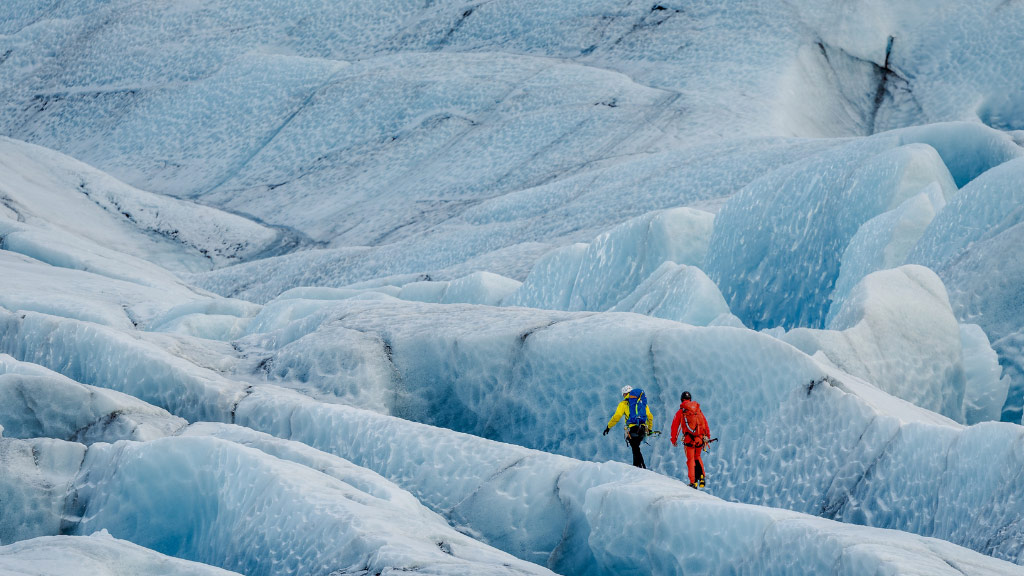
The landscapes around, and on, the glaciers can change drastically between seasons.
Be informed about typical seasonal differences
Seasonal variations in the landscape need careful thought. In winter, snowfalls can be heavy on trails close to glaciers. Severe storms can blow in and with limited hours at your disposal it’s easy to find yourself rushing because of fading light. Hiking in winter is therefore not advisable, particularly in remote upland areas.
Spring can be especially unpredictable. Late snowfalls after periods of warmer fine weather can easily catch you off guard and there is often a marked difference between upper and lower sections of trails. In autumn, conditions can also be extremely variable. River levels also vary according to the season due to the influence of glacial meltwater. Even in summer, understand that in rainy conditions, streams can quickly swell. This can have implications for trails that involve fording water; the widest and shallowest part of the river is usually best.
What may be a trickle in dry conditions and perfectly safe to step across can be dangerous when water levels are higher. If you aren’t confident that you can safely make it across – and if it’s an out and back trail, back again later on – then you should be prepared to turn back.

One of the ways to protect yourself on an Icelandic glacier is to be well prepared with good equipment.
How can you protect yourself in an environment characterised by changing weather conditions?
- Be proactive
The Icelandic Met Office provides detailed weather forecasts for numerous locations around the country. These are a good starting point if you plan to be outdoors enjoying activities such as hiking around glaciers. You’ll get an idea of expected wind speeds, figure out whether it’s likely to rain and see if the weather conditions are similar across the island or vary from place to place.
- Pay heed to any warnings given
If inclement weather is forecast to such a degree that there’s a likelihood it could impact everyday activities such as making driving difficult, then warnings are published. As a visitor, accept that you aren’t an expert and take advice from those that are. Hiking in exposed spots such as those found around Iceland’s glaciers not only puts your life in danger but that of those whose job it might be to rescue you should you find yourself in trouble.
- Dress for changing conditions
Hiking around Iceland’s glaciers shouldn’t be taken lightly. This isn’t akin to a stroll in an urban park. Layering items of clothing means you can add or take off items as the weather changes. You’ll need performance clothing that can keep you warm and dry should weather conditions deteriorate, as well as a day pack that can comfortably accommodate the layers you might need to take off so that you always have free hands.
- Make sure you have the right gear
In parts of the Icelandic countryside you’ll need the kind of gear that gives you a good grip, particularly if incoming rain, sleet or snow lubricates the trail’s surface and makes it more slippery than usual. Choose hiking boots with a decent tread and ankle support, use hiking poles and in winter, carry crampons to slide over your boots should you need additional grip. Remember that conditions often vary considerably along different sections of a trail.
- Carry adequate navigation and safety aids
Be sure to carry a first aid kit and headlamp, just in case, as well as adequate provisions and plenty of water. It’s also necessary to prepare for remote rural hikes so that you can find your way. If fog descends, the landmarks that you might be reliant upon in a written description of a route could be invisible. Having a GPS and compass with you is essential – as is knowing how to use them. Don’t rely on getting a mobile phone signal; instead carry a detailed paper map and a waterproof cover for it. Check your position regularly; if you become lost, retrace your steps to where you were last certain of your location.
- Tell someone where you are going
If you intend to hike near to Iceland’s glaciers independently, it’s a wise precaution to advise others of your plans prior to setting out. This could be as formal as filing an itinerary with ICE-SAR or simply telling your hotel where you will be hiking and approximately what time you intend to return. Doing so means that should the unthinkable happen, it’s likely that help would reach you more quickly.
Don’t let Iceland’s changeable climate put you off hiking around glaciers altogether. With thorough preparation, staying safe shouldn’t be problematic. Nevertheless, it’s best to take a common sense approach and make sure your plans are flexible. That means if weather conditions don’t look conducive to an enjoyable and safe hike you can postpone for another time.


